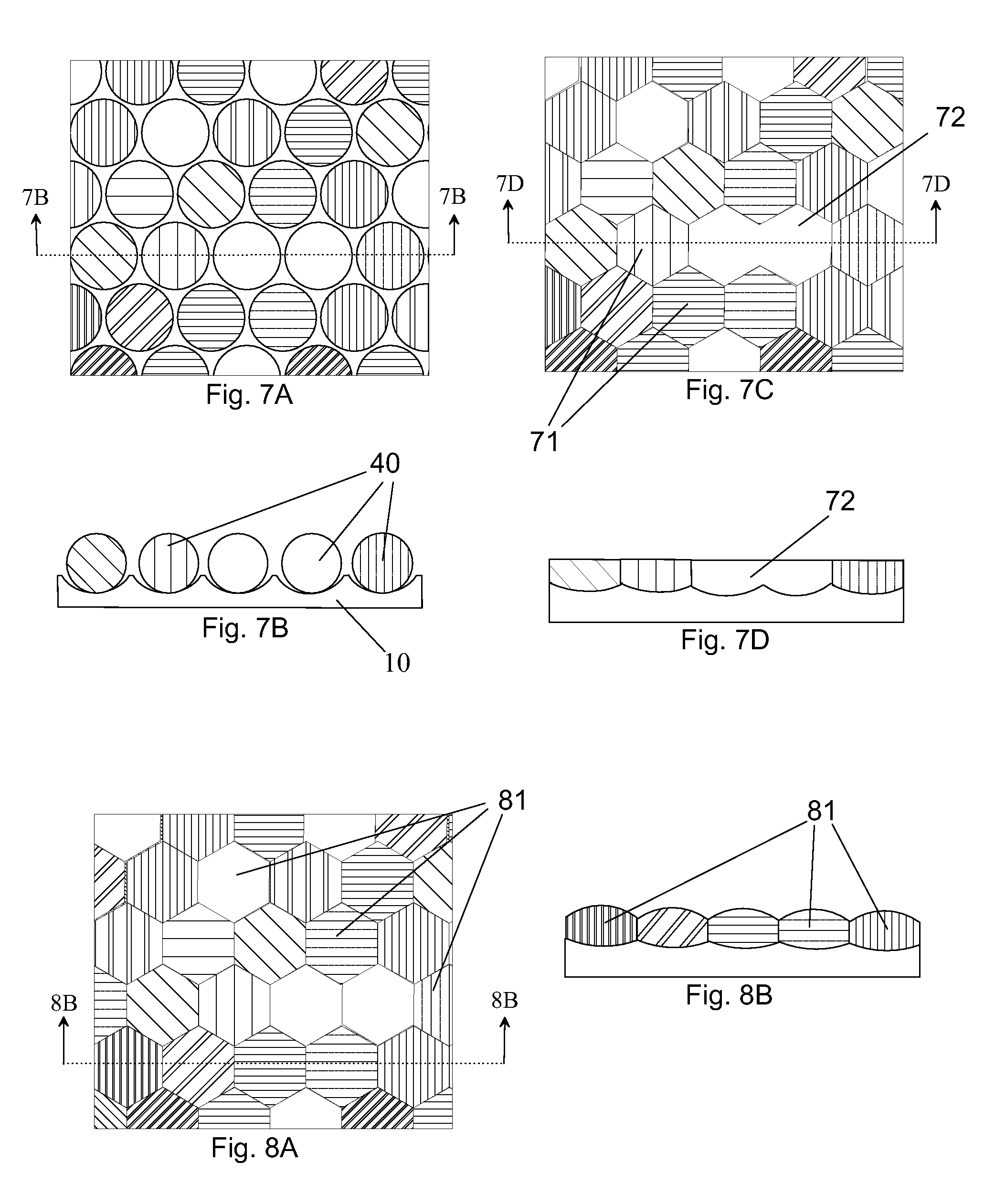Preforms for Creating Decorative Fused Glass
a technology forms, which is applied in the field of decorative fused glass objects, can solve the problems of high stress and fragmentation, difficult for novice or even experienced glass craftsmen to obtain the results they plan, and high risk of cutting glass and working with cut glass, so as to achieve the effect of predictability
- Summary
- Abstract
- Description
- Claims
- Application Information
AI Technical Summary
Benefits of technology
Problems solved by technology
Method used
Image
Examples
example 1.1
Using a Hexagonal Grid Base Sheet and Ball Preforms to Create a Fused Glass Object having a Mosaic Pattern of Small Hexagons. (FIGS. 7A Through 7D)
[0076]The preforms are used in the following way:
[0077]The ball preforms 40 are placed in the indentations of the hexagonal grid base sheet 10 in the color arrangement desired in the fused glass mosaic object to be made. FIGS. 7A and 7B shows a part of such an arrangement. The placement of colors could be planned with design sheets, planned with computer graphics, or inspired as the balls are placed.
[0078]The combination of the hexagonal base sheet and ball preforms as arranged above is heated in a kiln to fuse all these preforms together into a single relatively flat decorative glass object (FIG. 7D). As glass balls melt they are deformed by gravity and spread out to meet one another forming a mosaic of hexagons 71. Note that neighboring elements of the same color fuse together seamlessly into a single element 72. The ball preforms fuse ...
example 1.2
Using a Hexagonal Grid Base Sheet and Ball Preforms to Create a Fused Glass Object Having a Mosaic Pattern of Hexagonal Lenses. (FIGS. 7A, 7B, 8A and 8B)
[0081]Using the same preforms proceed as in example 1.1 above except using somewhat less heating (lower peak temperature or shorter duration at high temperature) in the kiln. The balls when heated somewhat less do not flatten out completely but retain a domed form 81 (FIGS. 8A and 8B) that refracts light in the manner of a small colored lens.
[0082]When viewing a scene through such a fused glass object each small lens shows a miniature inverted image of the scene colored by the color of the glass. The resulting array of small images colored by the various glass elements can be quite striking[0083]Note that the combination of gravity and surface tension effects will shape a variety of raised forms into rounded domed structures. Thus, the ball preforms 40 need not be spherical. For glass objects less than about 10 mm surface tension ef...
example application 1.3
Using a Rectangular Grid Base Sheet 20 and Ball Preforms 40 to Create a Fused Glass Object Having a Pattern of Square Elements. (FIGS. 9A Through 9D)
[0084]FIGS. 9A and 9B show a sections of a rectangular grid preform 20 having all the indentations filled with ball preforms 40. When this arrangement is fused into a glass object it will have a mosaic pattern of square elements 91 shown in FIGS. 9C and 9D. The square elements in the mosaic could be either flat or domed forming lenses depending on the temperature profile used in fusing.
[0085]Since adjacent ball preforms of the same color fuse together seamlessly, grouping ball preforms of the same color together in the layout results in larger mosaic elements.
PUM
| Property | Measurement | Unit |
|---|---|---|
| Color | aaaaa | aaaaa |
| Size | aaaaa | aaaaa |
| Shape | aaaaa | aaaaa |
Abstract
Description
Claims
Application Information
 Login to View More
Login to View More - R&D
- Intellectual Property
- Life Sciences
- Materials
- Tech Scout
- Unparalleled Data Quality
- Higher Quality Content
- 60% Fewer Hallucinations
Browse by: Latest US Patents, China's latest patents, Technical Efficacy Thesaurus, Application Domain, Technology Topic, Popular Technical Reports.
© 2025 PatSnap. All rights reserved.Legal|Privacy policy|Modern Slavery Act Transparency Statement|Sitemap|About US| Contact US: help@patsnap.com



